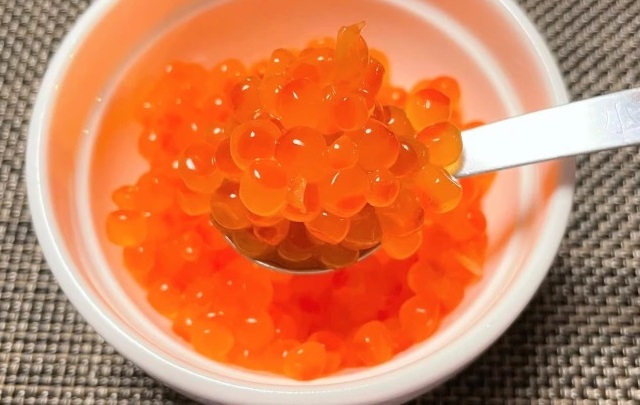
Is substitute salmon roe the budget-friendly food we’ve been hoping for?
Ikura (salmon roe) isn’t cheap, as anyone who’s ever looked at the menu at a sushi restaurant knows, and since even a bite-sized morsel is pricy, that makes a full-on ikura-don, an entire rice bowl topped with ikura, a special-occasion luxury.
Because of this, our Japanese-language reporter K. Masami sometime finds herself in situations where her stomach is saying “Gimme some ikura!”, but her wallet is saying “Nope.” But maybe there’s a way for Masami to please her palate without busting her budget, in the form of Hobo Ikura, or “Almost Ikura.”
Hobo Ikura is a new offering from Kobe-based food company Kanetetsu, and by its own admission, no, Hobo Ikura is not ikura. Kanetetsu promises it’s close, though. Made of vegetable fats and dextrin starch, Hobo Ikura is seasoned with salmon extract, mirin (cooking sake) and soy sauce to look and taste like actual ikura, Kanetetsu promises.
Why go to the trouble of making imitation ikura? Well, for starters, Hobo Ikura is lower in cholesterol and purines than ikura (regular ikura is eggs, after all). Then there’s the price difference. The 50-gram (1.8-ounce) pouch of Hobo Ikura Masami bought for this taste test cost 480 yen (US$3.60). The 60-gram pouch of ikura she picked up at the grocery store to compare it against? 1,078 yen. That works out to 9.6 yen per gram for Hobo Ikura compared to just under 18 yen per gram for ikura, making Kanetetsu’s facsimile roughly half the price.
▼ Hobo Ikura
Masami started off with a visual inspection, and was amazed by how close Hobo Ikura looks to the real thing. Honestly, if she were seeing it for the first time and it was already out of its packaging, she wouldn’t be able to tell it’s imitation roe. As proof, here’s a side-by-side comparison. Can you tell which is Hobo Ikura and which is ikura?
The real ikura is the bowl and the left, and Hobo Ikura is on the right. The only difference Masami could spot was that the real ikura was maybe a little more transparent, but that could just be the specific pack that she got.
▼ Real ikura
▼ Hobo Ikura
Masami was in for a surprise, though, when she tasted both, because the difference in flavor was bigger than the one in appearance. The Hobo Ikura has a more pronounced fish flavor and gelatin-like texture than the milder ikura, which also has more of a firmness-giving-way-to-a-pop consistency.
So is Hobo Ikura a failure then? Not at all. It’s still tasty, and there’s a way to make it even better while closing the gap between actual salmon roe: put it on a bowl of warm white rice.
As the heat transferred from the rice to the Hobo Ikura, it improved both the texture and the flavor, making both closer to ikura. Now not only did they look almost exactly the same, they tasted almost exactly the same too, and Masami isn’t sure she’d have been able to tell which was which anymore if she hadn’t put the ikura/Hobo Ikura bowl together herself.
▼ Left: real ikura
Right: Hobo Ikura
So when ikura isn’t in the budget, “almost ikura” is close enough for Masami.
Photos © SoraNews24
● Want to hear about SoraNews24’s latest articles as soon as they’re published? Follow us on Facebook and Twitter!
[ Read in Japanese ]